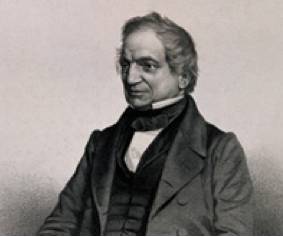Adam Sedgwick
Biography
|
|
EUGENE M. MCCARTHY, PHD
| < | Famous Biologists | > |
 Adam Sedgwick
Adam Sedgwick
|
Adam Sedgwick (1785–1873). British paleontologist; namer of the Devonian and Cambrian periods. One of the foremost scientists of his era.
Sedgwick began his life in the rural setting of the Yorkshire Dales in northern England. Despite his family's modest means, he managed to make his way through school on scholarships, and eventually came to Cambridge University, where he became a member of the board of governors when he was only 25 years old.
In 1818 he was elected Woodwardian Lecturer at the University. Known today as the Woodwardian Chair of Geology, this position had traditionally been held by geologists, but Sedgwick was entirely ignorant of the subject when he entered his new post. Apparently, his colleagues had granted him the position on the decease of its former occupant, John Hailstone, simply to supply the impecunious Sedgwick with a living. As he later quipped,
Sedgwick was the first scholar at the University to begin serious acquisition of specimens for Cambridge's geological collections. He contributed his own finds and acquired many fossils from other collectors, including Mary Anning, from whom he purchased several ichthyosaur specimens still on display there. The collection was first opened to the public in 1840.
According to Milner (1993), Adam Sedgwick had an "essentially generous and placid nature" and was "much beloved by many generations of geology students." His lectures were hugely popular. As he put it himself in speaking to his students, "I cannot promise to teach you all geology, I can only fire your imaginations." It seems he did succeed in igniting the thoughts of at least one important student — Charles Darwin regained in Sedgwick's lectures the interest in geology he had lost during his time at Edinburgh University.
In the summer of 1831, just before Darwin shipped aboard the H.M.S. Beagle, Sedgwick took him on a "geologising" trip through northern Wales, where he taught him how to draw geological maps and to collect and describe specimens. This experience stood Darwin in good stead on the voyage, and he later sent Sedgwick many of the fossils he collected during the course of his duties as the Beagle's shipboard naturalist. At the time Sedgwick wrote to Darwin's childhood schoolmaster, Dr. Samuel Butler, saying,
Butler passed these compliments from the great geologist along to Darwin's family. Indeed, by reading before the Geological Society of London material Darwin was communicating from South America, Sedgwick did much to create for his student the great reputation he had himself predicted.
A progressive thinker, Adam Sedgwick opened his classes to women, something most of his contemporaries would scarcely have even considered. Another indication of his open mind was his public rejection, in 1831 as retiring president of the Geological Society, of creationist interpretations of geological data. It was an admission of error of the sort many academics would be unwilling to make:
He was also among the first British scientists to recognize the contributions of William Smith
The Cambrian-Silurian Controversy
|
|
|
Adam Sedgwick's rival Sir Roderick Murchison (1792–1871) |
|
|
| Adam Sedgwick in old age (1867) |
A long, and eventually bitter, controversy grew up between Sedgwick and fellow geologist Sir Roderick Impey Murchison (1792–1871), a wealthy aristocrat, who had given up fox hunting for a different outdoor sport — geology. The early collaboration of these two men laid the foundation for the eventual unraveling of the entire Paleozoic system.
But trouble began to brew in 1834, when Murchison discovered in northern Wales a formation that underlay, and thus was older, than the Old Red Sandstone of Devon (a deposit that had been described and named the Devonian by Sedgwick, and which had up to that time been considered the oldest in Great Britain). Murchison named his older formation the Silurian, for the Silures, an ancient Welsh tribe.
But Sedgwick soon found, in central Wales, a formation even older than Murchison's, and named it the Cambrian. Murchison, chagrined, said Sedgwick had taken the lower portion of his Silurian formation and merely given it a new name.
|
Other early naturalists:
|
The resulting argument ruined their friendship. The bickering went on for years, and in the end it seemed Murchison had won out — he arranged for himself to be appointed head of the British national geological survey, and then used his powers to have the name "Cambrian" deleted from all books and maps published by the government.
After both were dead, though, the Cambrian was revived, and has since been increasingly studied, whereas attention to Murchison's Silurian has generally declined. So it seems Adam Sedgwick has had the last laugh.
Next page >>
Most shared on Macroevolution.net:
Human Origins: Are we hybrids?
On the Origins of New Forms of Life
Mammalian Hybrids
Cat-rabbit Hybrids: Fact or fiction?
Famous Biologists
Dog-cow Hybrids
Georges Cuvier: A Biography
Prothero: A Rebuttal
Branches of Biology
Dog-fox Hybrids